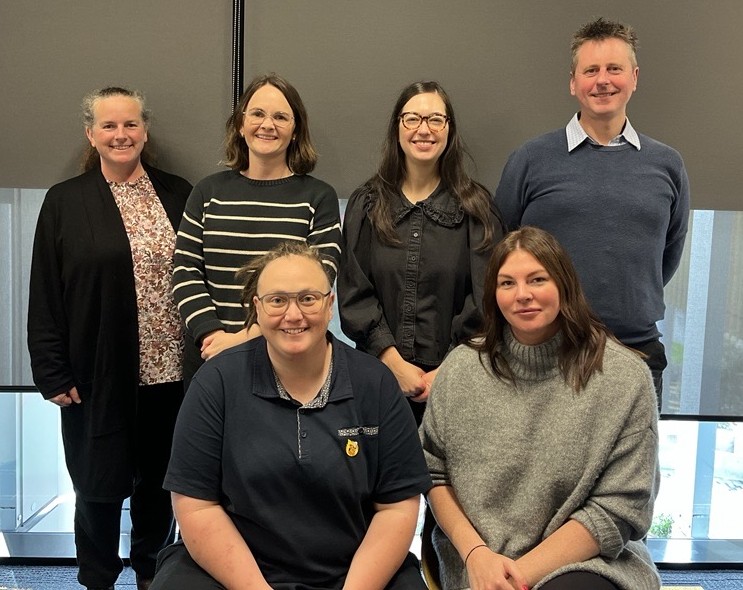Accessibility as a purpose: Deakin’s Student Web Uplift project

Front, left to right: Lauren Gwyn, Abby Smith
Back, left to right: Cheryl Page, Kat Barber, Jessica Kalamaris, Steven Richards
Websites are a critical point of information for higher and further education institutions. Often the first stop for potential students, getting them right is essential to making a good impression and turning future students into current ones.
And getting it right means making it accessible to anyone who might click on it, as Deakin University recently discovered.
The Student Web and Digital Experience team undertook a major upgrade of the student website to improve accessibility for all users. Led by Steven Richards, the team drew on their existing accessibility knowledge, along with their design, development, and testing expertise, to make meaningful and lasting improvements.
Getting started
The scale of the task is daunting to think about: 2400 pages and 350 authors, for a website that attracts over 13 million views each year. But Fiona Greig, Director of Student Experience and Engagement, said it was important to enhance the student experience and make the website more accessible for everyone.
The Web Uplift project had several aims, according to Fiona, including:
- Replacing the existing search function with Funnelback, a more accessible function;
- Adding new content tools that apply rigorous user and accessibility testing across the Current Student website;
- Improving information architecture, site navigation, and ensuring consistency in naming conventions across the site;
- Establishing a unified web governance model across the Public Web, Library, and Current Student website; and
- Developing a sustainable model for student journeys on the site.
But the very first step was to establish what was already there and what content needed to be changed or updated, as Fiona explained.
“The project began with a thorough and exhaustive content audit,” she said.
“We also conducted a significant benchmarking exercise, rigorous accessibility checks, and user experience testing that helped identify areas for improvement and guided the re-write of content aligned with the recommended information architecture and navigation.”
This content audit, and the re-writing of content that followed to align it with the new information architecture and navigation system, was the most challenging part of the whole project according to Fiona.
Stabilising content tools to new accessible ones was the easiest though, as it allowed the team to be creative and gave them a sense of purpose with “student experience at the centre”, Fiona said.
As the Web Uplift project progressed, staff and student working groups were established to ensure the perspectives of both groups were considered throughout the process. These working groups provided continuous feedback on website navigation, content clarity, and accessibility improvements. They played a key role in testing and validating changes before implementation, ensuring that the enhancements truly met the needs of students.
Student benchmarking, user experience studies and student journey tracking added to the knowledge that the Student Web and Digital Experience team was able to draw on as they carried out the project, ensuring they created a user-friendly space.
By adopting a continuous improvement cycle, the team ensured that the new website remains dynamic and evolves alongside student needs and accessibility standards. Automated and manual accessibility testing is conducted regularly, ensuring that the site maintains the same high level of compliance as it had at launch.
“The rigorous design, development and testing process that was developed through the project is still used for every release and update. System site-wide testing and reporting is conducted daily to ensure accessibility benchmarks are met,” Fiona said.
The importance of an accessible website
The project spanned 18 months, significantly improving the accessibility and usability of the student website. The team worked to address a wide range of accessibility issues, aligning the site more closely with WCAG AA standards. Throughout the project, a structured testing and remediation process helped resolve key barriers, with ongoing improvements continuing beyond the initial launch.
As part of the uplift, new content tools were introduced to support accessible content creation, and benchmarking processes were enhanced to track future accessibility improvements.
Fiona said the new website is vital for students of all abilities.
“Accessibility is crucial for websites on this scale to ensure that all students, regardless of their abilities, can access and benefit from the information and resources provided. It supports the university's strategic goals of digital delivery and innovation, as well as optimizing access, participation, and success for all students.”
The team was recognised for its success at the ADCET Accessibility in Action Awards last year, which Greig said was a “significant achievement and recognition of the team’s hard work and dedication to accessibility and inclusion”.
“We are very proud of the leadership the team takes in this space. Their dedication to ensuring an accessible inclusive experience is our true north,” she added.
The Web Uplift project led directly to another: late in 2024, the same team assisted in the creation of accessible content tools for the University Library website, adding to the inclusive experience across the university. Fiona said the team will continue to work on improving the student web experience at Deakin and “exploring accessible, inclusive and sustainable personalisation”.
“Our focus and goals will remain the same: enhanced student experience and ensuring accessibility and inclusion. The team's dedication and collaboration have been key to its success,” she said.
Written by: Danielle Kutchel
March 2025

